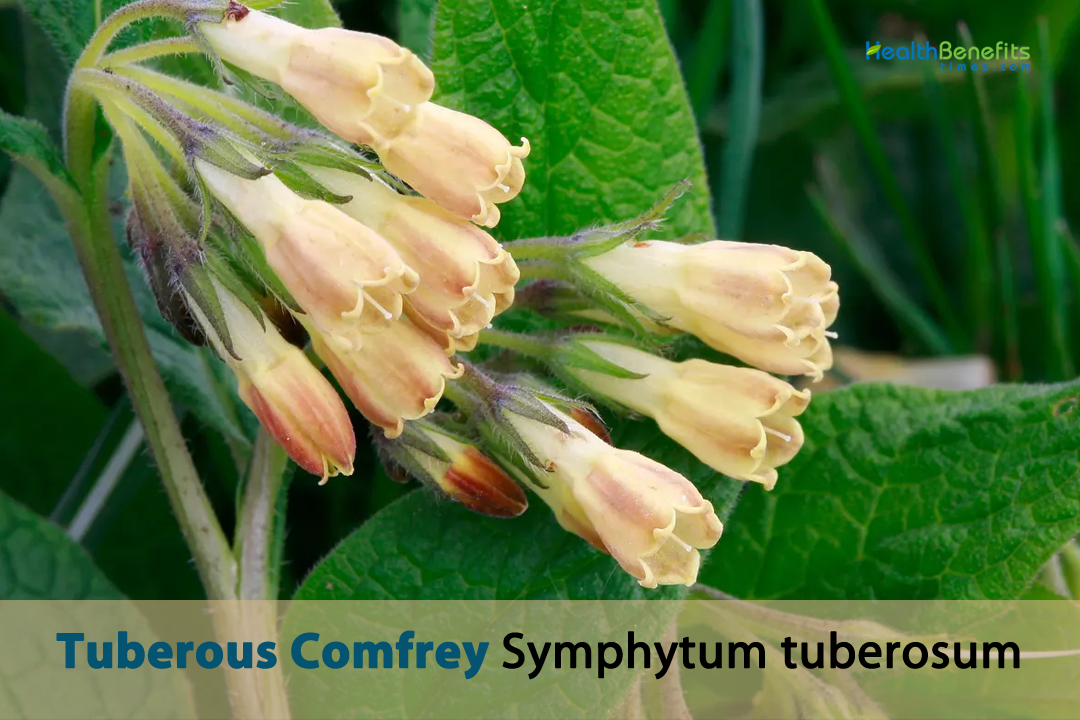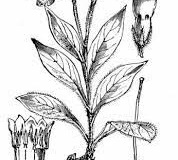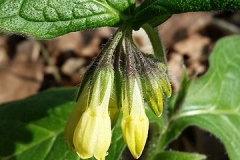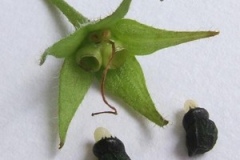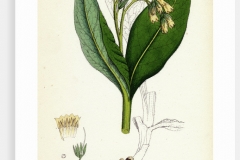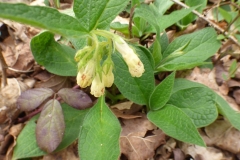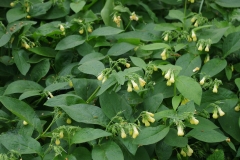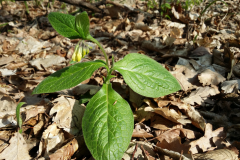| Tuberous Comfrey Quick Facts | |
|---|---|
| Name: | Tuberous Comfrey |
| Scientific Name: | Symphytum tuberosum |
| Origin | Europe and Western Asia and has been naturalized in North America |
| Colors | Brown |
| Shapes | Small clumps of brown, nut-shaped seeds |
| Taste | Slightly bitter and astringent taste, with some hints of sweetness |
| Health benefits | Anti-inflammatory properties, Pain relief, Wound healing, Digestive health, Respiratory health, Skin health, Bone health, Anti-cancer properties |
| Name | Tuberous Comfrey |
|---|---|
| Scientific Name | Symphytum tuberosum |
| Native | Europe and Western Asia and has been naturalized in North America |
| Common Names | Tuber comfrey, tuberous-rooted comfrey, Creeping Comfrey, Knit bone, blue Comfrey, Heal-all, Gum Plant, Boneset, Slippery Root, Ass’s Ears, Russian Comfrey, Healing Herb, Black wort, Bruise wort, Wall Comfrey, True Comfrey, Quaker Comfrey |
| Name in Other Languages | Albanian: Kufilmë Arabic: Kumfuri al-durni (كومفري الدرني), shaghat darania (شاغة درنية) Asturian: Consolda Basque: Zolda-belar txikia Bulgarian: Grudesto zarasliche (грудесто зарасличе) Catalan: Consolda menor, Consolda petita, Consolda tuberosa Chinese: Kuài yè zǐ cǎo (塊葉紫草) Croatian: Cvorasti gavez Czech: Kostival hlíznatý Danish: Knoldet Brunrod, Knoldet Benved, Knold-kulsukker, Knoldet kulsukker Dutch: Knolbevondere hondstong, Knolbevrijding, Knolssmeerwortel English: Tuberous comfrey Finnish: Mättäätulikukka, Mukulakirjokanukka, Keltaraunioyrtti, French: Grande consoude bulbeuse, Consoude tubéreuse, Consoude à tubercules German: Knollige Beinwell, Knoten-Beinwell, Knolliger Beinwell, dicker Beinwell, knotige Wallwurz, knotiger Beinwell Hungarian: Gumós nadálytő, gumós nadályt Italian: Consolida bulbosa, Consolida tuberosa, Consolida femmina Japanese: Chūberosu konfurī (チューベロス・コンフリー ) Korean: Ulgeum (울금) Norwegian: Knollkomfrey, Knollettvedblom, Gulvalurt Occitan: Consuelda menor, oreja de burro, sariz Polish: Żywokost bulwiasty Portuguese: Consolda bulbosa Russian: Komfrey klubnenosnyy (Комфрей клубненосный), Okopnik klubnenosnyj (Окопник клубненосный) Serbian: Gomoljasta gavez (гомољасти гавез), žuti gavez (жути гавез) Slovak: Kostihoj hľuznatý Slovene: Gomoljasti gabez Spanish: Consuelda bulbosa, Consuelda menor, Consuelda tuberosa, Consuelda turmosa, Cunsuelda amarilla, Gargacheta, Oreja de burro, Simfito menor, Sinfito menor, consolba menor, consolba petita, consuelda de cepa, nualós, suelda, suelda-costillas, sínfito Swedish: Knölsymfoni, Gul vallört, Keltaraunioyrtti Turkish: Karakafesotu yumrulu, Yumrulu karakafes out, şiş tomara Ukrainian: Zhyvokist bulʹbonosnyy (живокіст бульбоносний) Upper Sorbian: Tołste kosćadło Welsh: Cyfardwf Glorog, Cyfardwf Oddfynog, Llysiau’r Cwlwm |
| Plant Growth Habit | Perennial herbaceous plant |
| Growing Climates | Commonly found in meadows, pastures, along roadsides, woods, scrub and by rivers |
| Soil | Prefers well-draining soil that is rich in organic matter. The plant can tolerate a range of soil types, but it does best in moist, loamy soil |
| Companion Plants | Yarrow, Chamomile, Nasturtium, and Borage |
| Plant Size | 8-12 inches tall and 24-30 inches wide |
| Root | Deep, thick taproot. They are brown and knobby, and they can be up to 6 inches long |
| Stem | Green stem that grows straight up. It has stiff, hairy extensions all over it that make it feel rough |
| Bark | Rough, woody bark that can be anywhere from grayish-brown to dark brown in color. |
| Leaf | Hairy, lance-shaped leaves that can grow up to 20 centimeters long and 15 centimeters wide |
| Flowering season | May to July |
| Flower | Flowers are bell-shaped and range in color from white to pale pink or purple. They appear in clusters on the top of the stems. |
| Fruit Shape & Size | Small clumps of brown, nut-shaped seeds that are wrapped in a burr-like husk |
| Flavor/Aroma | Somewhat earthy and slightly herbal aroma |
| Taste | Slightly bitter and astringent taste, with some hints of sweetness |
| Plant Parts Used | Roots, leaves, and flowers |
| Propagation | By seed but more commonly by root division |
| Lifespan | Can live for up to 15-20 years or even longer under ideal growing conditions |
| Season | August to October |
| Available Forms | Poultices, infusions, decoctions, tinctures, and extracts |
| Vareties |
|
| Health benefits |
|
Plant Description
Tuberous comfrey is a type of annual herbaceous plant that usually grows to a height of 8–12 inches and a width of 24–30 inches. It usually grows in fields, pastures, along roadsides, in woods and scrub, and near rivers. This plant does best in soil that drains well and has a lot of organic matter. Even though it can grow in many kinds of soil, it does best in wet, sandy soil. It needs water all the time, but it can’t grow in dirt that is too wet. During dry times, you should water the plant deeply once a week, but let the soil dry out a little between waterings.
Stem
The tuberous comfrey plant has a green stem that grows straight up. It has stiff, hairy extensions all over it that make it feel rough. The stem can have branches or not have any. One thing that makes it different is that it is hollow, which is something that many plants in the family Boraginaceae have in common.
Bark
The Tuberous Comfrey plant has rough, woody bark that can be anywhere from grayish-brown to dark brown in color. Most of the time, it is picked in the fall, when the plant is at its strongest. After the bark is taken off, it is dried and used as medicine. This bark has a lot of useful substances in it, such as allantoin, rosmarinic acid, and mucilage.
Leaves
Tuberous comfrey is a plant with big, broad, rough, dark green leaves. These leaves grow on opposite sides of the plant, and because they are hairy, they look a little fuzzy. The leaves are oval with a sharp point at the end. They can grow up to 20 centimeters long and 15 centimeters wide. The edges of the leaves are a little bit curved or wavy, and the midrib is easy to see. One thing that makes Tuberous comfrey leaves special is that they can store a lot of pyrrolizidine alkaloids.
Flowers
Tuberous comfrey is a type of grass that grows back every year and has small flowers that look like bells. Most of the time, these flowers are pink, purple, or blue, and they grow in groups at the end of the stems. They are hermaphrodite, which means they have both male and female parts that help them reproduce. The flower is made up of a thin tube with five lobes that stick out. The flower looks delicate and graceful because the lobes have fringed ends and a small curve. Depending on the weather and how the plant grows, tuberous comfrey flowers usually bloom in late spring or early summer. They provide important food for pollinators and are a beautiful addition to any yard. Pollination happens when bees and other insects move pollen from one flower to another while taking nectar from the plant. This is how the plant makes seeds and keeps its life cycle going.
Fruits
The tuberous comfrey makes small clumps of brown, nut-shaped seeds that are wrapped in a burr-like husk. These husks can stick to clothes and animal fur, which helps the seeds spread over a larger area. The seeds can be eaten, and they have a mild, sweet taste. You can eat them raw or roast them, and sometimes people use them instead of coffee. But it’s important to know that the plant’s leaves and other parts contain pyrrolizidine alkaloids, which can be harmful to both people and animals if they eat too much.
Health Benefits of Tuberous Comfrey
Tuberous Comfrey has been used as medicine for hundreds of years, and it may have a number of health benefits. But it’s important to remember that more study is needed to fully understand the plant’s effects on the body and figure out safe and effective dosages. Before using Tuberous Comfrey, you should talk to a doctor or nurse, just like you should before using any other plant remedy.
1. Anti-inflammatory properties
In the past, Tuberous Comfrey has been used to help reduce pain. Scientists have found that the plant has chemicals that can stop the production of cytokines that cause inflammation. This makes inflammation less severe. Because of this, Tuberous Comfrey might be a good way to treat conditions like gout, asthma, and inflammatory bowel disease.
2. Pain relief
The Tuberous Comfrey has qualities that can help relieve pain and discomfort. According to scientific studies, the compounds in this plant can stop pain messages from getting to the brain. This makes it a good treatment for back pain, joint pain, and headaches.
3. Wound healing
In the past, Tuberous Comfrey has been used to help wounds heal and for tissue to grow back. Scientists have found that the chemicals in the plant can speed up the healing process by making it easier for cells to multiply and for collagen to be made. Because of this, Tuberous Comfrey could be a good way to treat skin sores, burns, and other wounds.
4. Digestive health
Tuberous comfrey is a plant that has been used for a long time to help with digestion. Compounds in this plant can make stomach juices come out faster, make bile flow faster, and help the gut move better. Because of this, Tuberous Comfrey might be able to help with problems like heartburn, constipation, and diarrhea.
5. Respiratory health
Tuberous comfrey has been used for a long time to improve the health of the lungs. Its chemical parts can help stop coughing, soothe sore throats, and reduce swelling in the lungs. Because of this, Tuberous Comfrey may be able to help with the symptoms of coughing, asthma, and allergies.
6. Skin health
Tuberous comfrey has been used for a long time to improve the health of the face. Its chemical ingredients can help heal skin problems like eczema, psoriasis, and acne by reducing swelling and redness and helping to heal wounds.
7. Bone health
Since ancient times, Tuberous Comfrey has been used to help keep bones healthy. The chemicals in the plant can increase bone density, make it less likely that bones will break, and speed up the time it takes for bones to heal. So, Tuberous Comfrey has potential as a treatment for diseases like osteoporosis and broken bones.
8. Anti-cancer properties
Studies have shown that Tuberous Comfrey contains some chemicals that can help fight cancer. Compounds in the plant can stop cancer cells from growing and make them die by a process called “programmed cell death.” Based on these results, Tuberous Comfrey might be able to be used to treat cancer.
Traditional uses and benefits of Tuberous Comfrey
- It has been used for a long time to help a wide range of illnesses, such as arthritis, asthma, skin problems, and digestive issues.
- Tuberous comfrey can be used in a lot of different ways, like as a poultice, a blend, a decoction, a tincture, or an extract.
- Tuberous comfrey is often used to treat damage to the muscles and bones.
- Tuberous comfrey has traits that can help heal wounds and speed up the growth of new skin cells.
- It has been used to ease the pain of injuries like bruises, sprains, and strains and to reduce the swelling that comes with them.
- It has helped people with stomach problems like ulcers and gastritis, which is an inflammation of the walls of the stomach.
- People have used this drug to treat coughs, bronchitis, and other respiratory problems.
- This method has been used to treat skin problems like eczema, psoriasis, and acne.
- It’s good for bone health and can help broken bones heal faster.
- People have used it to ease joint pain and reduce inflammation caused by diseases like arthritis.
- It is put on the skin to help heal cuts, burns, and other skin problems.
- The plant’s root has mucilage, which is a gel-like substance that can help soothe and protect sore or sensitive tissues.
Culinary Uses
The roots of the plant are the most commonly used part, as they contain a mucilaginous substance that has several culinary applications. Here are a few ways in which tuberous comfrey is used in cooking:
- Thickening agent: The mucilaginous substance present in comfrey roots can be utilized as a thickener in soups, stews, and gravies.
- Emulsifier: The mucilage can serve as an emulsifier in salad dressings by aiding in the blending of oil and vinegar.
- Gluten-free baking: The mucilage can also be used as a gluten substitute in baking, as it aids in binding the ingredients together and creating a chewy texture.
- Beverage: Comfrey roots can be used to prepare a tea or infusion that is believed to have a calming effect on the digestive system..
- Condiment: The leaves of comfrey can be utilized to create a condiment resembling pesto, which can be used as pasta topping or spread on bread.
Other Uses
Here are some different uses of Tuberous Comfrey
- Companion plant: Tuberous comfrey is often used as a companion plant in gardens due to its deep roots, which can bring up nutrients from the soil. Additionally, the plant’s leaves can be employed as mulch to help retain moisture in the soil.
- Livestock feed: Tuberous comfrey has been utilized as a forage crop for livestock because of its high protein content.
- Soil conditioner: Tuberous comfrey has also been employed as a soil conditioner and fertilizer, as it contains high levels of nutrients.
- Decorative plant: Tuberous comfrey is also grown for its ornamental value, as its beautiful foliage and flowers can enhance the aesthetic appeal of gardens.
Precautions
Tuberous comfrey is also grown for its ornamental value, as its beautiful foliage and flowers can enhance the aesthetic appeal of gardens.
- Do not ingest: Tuberous Comfrey is a plant that contains pyrrolizidine alkaloids, which can be poisonous if consumed. It is crucial to avoid ingesting any portion of the plant.
- Do not apply to broken skin: Tuberous Comfrey, when applied to the skin, can enter the bloodstream. It is crucial to avoid using it on broken skin because it can cause toxicity.
- Avoid during pregnancy and breastfeeding: It is not safe to use Tuberous Comfrey during pregnancy and breastfeeding as it can be harmful to the developing fetus and infants. It is recommended to avoid its use during this time.
- Consult a healthcare professional: It is crucial to seek advice from a healthcare professional before using Tuberous Comfrey for medicinal purposes. They can provide guidance on the suitable dosage and potential interactions with other medications.
- Use only under supervision: The use of Tuberous Comfrey should only be done under the guidance and supervision of a healthcare professional. It should not be used as a replacement for traditional medical treatment.
References:
https://www.itis.gov/servlet/SingleRpt/SingleRpt?search_topic=TSN&search_value=32030#null
https://pfaf.org/user/plant.aspx?latinname=Symphytum+tuberosum
https://gd.eppo.int/taxon/SYMTU
https://en.wikipedia.org/wiki/Symphytum_tuberosum
https://plants.usda.gov/home/classification/45436


